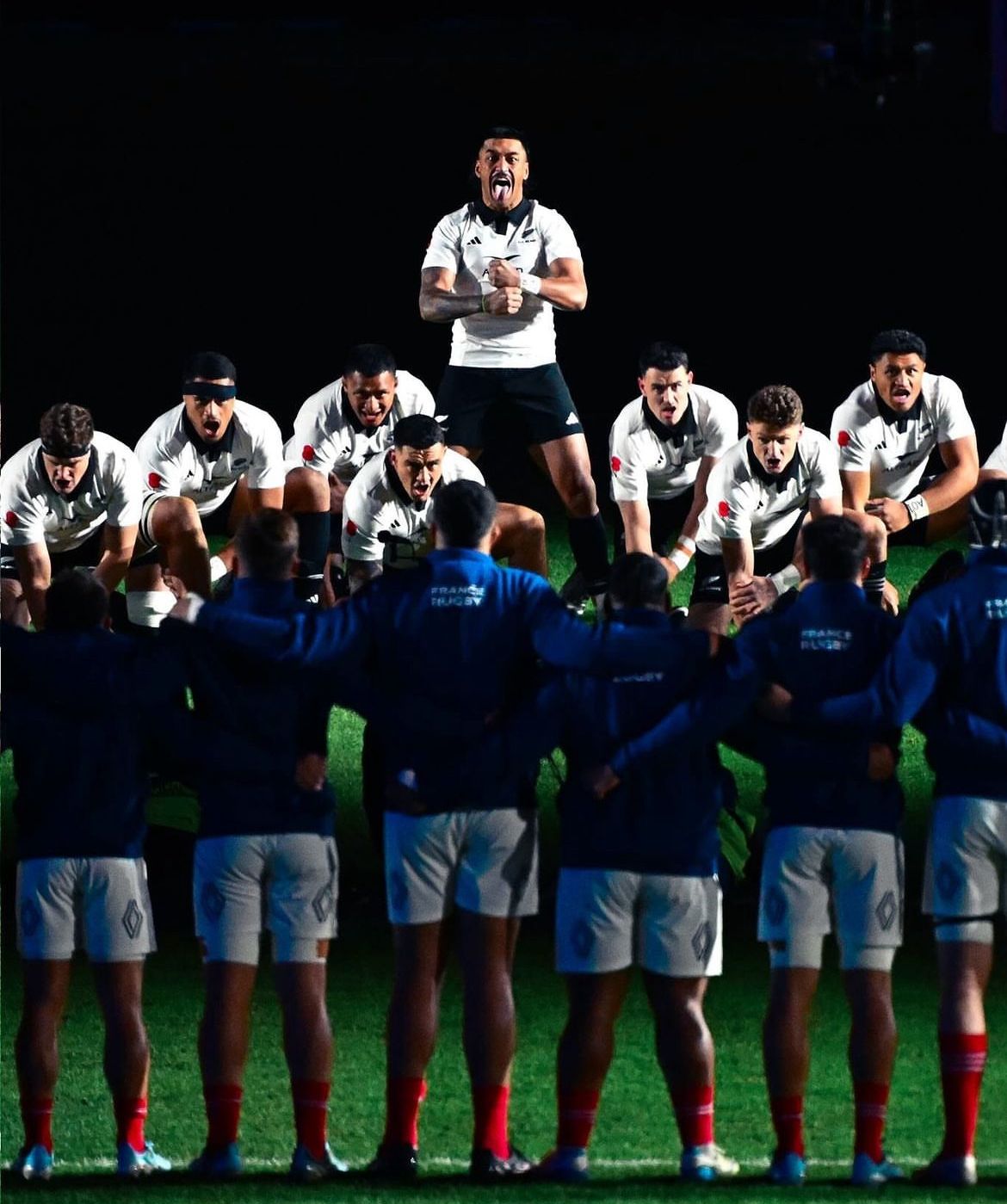All Blacks v France
-
@mariner4life said in All Blacks v France:
@Mauss said in All Blacks v France:
@DaGrubster said in All Blacks v France:
They don’t really have a bigger pack to select.
Perhaps bigger is not the right word. Players who thrive more in the tight spaces, something like that? Against France, NZ tried to keep the ball tight and go through the middle in the French 22 but the pick and go was very messy. Cleaners were often unable to keep their feet at the ruck and carriers didn't dominate contact, leading to a lack of forward momentum and French turnover ball.
Ireland’s win against South Africa in Durban came after selecting Beirne at six and playing more directly. They then tried a similar line-up against NZ (without playing as direct) and it didn’t work. I don’t want to simplify things too much, but with how close the top teams are (with Argentina and Australia on the rise), I’d think a horses for courses-approach might be best. In this approach, you’d have something like a "Crusader" gameplan for certain opponents (Ireland, England, Australia, Argentina) while taking on a Cotter/Schmidt/Blues-style for others like South Africa and France. The latter means more aggressive ruck defence, lots of blindside switches in attack, and picking players who excel in the pick and go and are able to dominate contact in close (Tu’ungafasi, Sotutu, Savea, Taukei’aho, Tuipulotu, etc.).
I don’t think it’s particularly likely that Robertson is going to go for something like this, but he can’t keep losing to teams with this playing style without coming onto serious pressure. I also don’t think this is unique to Robertson. Anyone who has been watching NZ U20s rugby for the past 12 years will probably have noticed how much these teams struggle with forward packs who stay tight together and flood the breakdown on attack and defence (some examples: SA 2012, ’14, ’19; FR 2018, ’23, ’24; WL 2012, ’19; IRL 2016; AU 2019, ’23). Those are a lot of coaches – Penney, Boyd, Robertson, Philpott, Laidlaw, Gibbes – who haven’t been able to successfully tackle this issue.
Robertson is a big believer in cohesion so that would go against this sort of mixed approach. I guess we’ll find out in the coming years whether cohesion is enough to overcome this close quarter forward-style.
It's totally philosophical.
If we wanted to play like France we totally could. But we are playing to outflank.
France play like an old school pack. Run hard as fuck, bash the ruck.
Neither is better than the other really. It comes down to if you do what you want AND stop the other team doing what they want.The ABs should watch Isaiah Yeo from Penrith. He's the master of the pass out the back, but if it's not on, he takes 12 metres.
If we can learn to make the pass while actually running we'll be unstoppable
If only we had some big munters who were athletic and had ball skills...
-
@antipodean said in All Blacks v France:
@mariner4life said in All Blacks v France:
@Mauss said in All Blacks v France:
@DaGrubster said in All Blacks v France:
They don’t really have a bigger pack to select.
Perhaps bigger is not the right word. Players who thrive more in the tight spaces, something like that? Against France, NZ tried to keep the ball tight and go through the middle in the French 22 but the pick and go was very messy. Cleaners were often unable to keep their feet at the ruck and carriers didn't dominate contact, leading to a lack of forward momentum and French turnover ball.
Ireland’s win against South Africa in Durban came after selecting Beirne at six and playing more directly. They then tried a similar line-up against NZ (without playing as direct) and it didn’t work. I don’t want to simplify things too much, but with how close the top teams are (with Argentina and Australia on the rise), I’d think a horses for courses-approach might be best. In this approach, you’d have something like a "Crusader" gameplan for certain opponents (Ireland, England, Australia, Argentina) while taking on a Cotter/Schmidt/Blues-style for others like South Africa and France. The latter means more aggressive ruck defence, lots of blindside switches in attack, and picking players who excel in the pick and go and are able to dominate contact in close (Tu’ungafasi, Sotutu, Savea, Taukei’aho, Tuipulotu, etc.).
I don’t think it’s particularly likely that Robertson is going to go for something like this, but he can’t keep losing to teams with this playing style without coming onto serious pressure. I also don’t think this is unique to Robertson. Anyone who has been watching NZ U20s rugby for the past 12 years will probably have noticed how much these teams struggle with forward packs who stay tight together and flood the breakdown on attack and defence (some examples: SA 2012, ’14, ’19; FR 2018, ’23, ’24; WL 2012, ’19; IRL 2016; AU 2019, ’23). Those are a lot of coaches – Penney, Boyd, Robertson, Philpott, Laidlaw, Gibbes – who haven’t been able to successfully tackle this issue.
Robertson is a big believer in cohesion so that would go against this sort of mixed approach. I guess we’ll find out in the coming years whether cohesion is enough to overcome this close quarter forward-style.
It's totally philosophical.
If we wanted to play like France we totally could. But we are playing to outflank.
France play like an old school pack. Run hard as fuck, bash the ruck.
Neither is better than the other really. It comes down to if you do what you want AND stop the other team doing what they want.The ABs should watch Isaiah Yeo from Penrith. He's the master of the pass out the back, but if it's not on, he takes 12 metres.
If we can learn to make the pass while actually running we'll be unstoppable
If only we had some big munters who were athletic and had ball skills...
We do, or at least did. One is playing in Japan, and before too long I expect one will be playing in the UK
-
@Bones said in All Blacks v France:
@Old-Samurai-Jack said in All Blacks v France:
I'd like to see his assist stats compared to other players. He seems to be a good link player.
Keen as! I'm intrigued what you're watching to think he's a good link player.
I am not as down on Jordan as you appear to be, but I admit to being disappointed in his development and agree with some of your, if not all (I feel dirty), criticisms of his play. I would add that I think we may have already seen the best of him unless he works out a way to become smarter in his decisions, develops a passing game and learns to work to put others in space. His speed is not always going to be a weapon (he doesn't seem as quick this year) and he doesn't have a step on him, so unless he can evolve his game he is going to end up another BB, possibly even a poor man's version.
-
@Crazy-Horse he's already about to turn 27. it is far more likely that this is the finished product than he continues to develop.
-
Jesus, he is basically at the AB winger used by date.
I’m not sure whether it is Covid or what, but I undercount everyone’s age by two or three years.
-
To me, his decision-making is suss in that playstation wants to score in the current movement every time way, and he totally has tunnel vision once he gets the ball - which is a shame because he makes breaks others wouldn't and if he could link we would undoubtedly score more tries.
He's still one of our best attacking weapons, and he gets the ball more at 15 than he does on the wing, and with more ability to insert himself.
If the alternative is BB or Perofeta, then I'm okay with WJ.
Stevenson and Love don't appear to be the full package either really, but wouldn't mind seeing them get some opportunity.
McKenzie would be better, but he's our best 10. -
@mariner4life said in All Blacks v France:
@Crazy-Horse he's already about to turn 27. it is far more likely that this is the finished product than he continues to develop.
Yeah that's what I am worried about. I have my fingers crossed he may develop 'smarts' though, but for once in my life I may be being too optimistic
-
@reprobate said in All Blacks v France:
To me, his decision-making is suss in that playstation wants to score in the current movement every time way, and he totally has tunnel vision once he gets the ball - which is a shame because he makes breaks others wouldn't and if he could link we would undoubtedly score more tries.
He's still one of our best attacking weapons, and he gets the ball more at 15 than he does on the wing, and with more ability to insert himself.
If the alternative is BB or Perofeta, then I'm okay with WJ.
Stevenson and Love don't appear to be the full package either really, but wouldn't mind seeing them get some opportunity.
McKenzie would be better, but he's our best 10.Re Stevenson and Love I think the selectors are definitely thinking the same way about Stevenson, but I would be surprised if they have written Love off just yet. Next year will be a big year fir Love. His form fell away this year, but that coincided with an injury he tried to play through. In hindsight, that may have harmed his reputation a little.
I think the above is why they are sniffing around Fihaki. He brings some attributes that Stevenson brings, but without the lazy looking brain farts. Don't get me wrong, I don't like the idea of Fihaki in the ABs but I can see the attraction.
-
I agree that WJ suits wing better. He is a weapon there. Opposite to the narrative on here, I think his distribution skills are good as he has consistently shown (try assist stats?) but the lack of a tactical kicking game and decision-making in a tight arm wrestle is a concern.
-
@Old-Samurai-Jack yeah I agree, his strike rate for us on the wing is crazy, you can't discount that. The guy knows how to find the try line and that's a huge plus in a tight test.
At the end of the day some players are suited to the role of decision maker, others are better as finishers. Jordan is 100% the latter. In the modern game you need your 9, 10 and 15 to call the shots and make the decisions. Roigard is superb in this regard (despite his age), DMac has improved hugely (though he will always be a bit of a risk taker if a chance presents itself which is not necessarily a bad thing), and Jordan just isn't suited to the role at all. That's why I have preferred BB at the back, but I think his days in the starting 15 are behind him now. I'd like to see Love and Perofeta given a lot more game time as they are both 10/15s so have experience calling the shots. Perofeta was very good against England before injury and Love is a a real talent that should be developed as soon as possible.
-
@Crazy-Horse said in All Blacks v France:
@Bones said in All Blacks v France:
@Old-Samurai-Jack said in All Blacks v France:
I'd like to see his assist stats compared to other players. He seems to be a good link player.
Keen as! I'm intrigued what you're watching to think he's a good link player.
I am not as down on Jordan as you appear to be, but I admit to being disappointed in his development and agree with some of your, if not all (I feel dirty), criticisms of his play. I would add that I think we may have already seen the best of him unless he works out a way to become smarter in his decisions, develops a passing game and learns to work to put others in space. His speed is not always going to be a weapon (he doesn't seem as quick this year) and he doesn't have a step on him, so unless he can evolve his game he is going to end up another BB, possibly even a poor man's version.
-
@Bones said in All Blacks v France:
@Crazy-Horse said in All Blacks v France:
@Bones said in All Blacks v France:
@Old-Samurai-Jack said in All Blacks v France:
I'd like to see his assist stats compared to other players. He seems to be a good link player.
Keen as! I'm intrigued what you're watching to think he's a good link player.
I am not as down on Jordan as you appear to be, but I admit to being disappointed in his development and agree with some of your, if not all (I feel dirty), criticisms of his play. I would add that I think we may have already seen the best of him unless he works out a way to become smarter in his decisions, develops a passing game and learns to work to put others in space. His speed is not always going to be a weapon (he doesn't seem as quick this year) and he doesn't have a step on him, so unless he can evolve his game he is going to end up another BB, possibly even a poor man's version.
Upvoted for the use of "undercover of darkness" by the Strokes in the video.
-
Being away all weekend I didn't get to see any of the tests live so didn't read this thread until now, after finally viewing the game.
On a couple of important decisions:
For the Ofa neck roll, Lakai cleaning from the side of that ruck made it look far worse than it was. If anyone should have been penalised it was him.
Sititi owes Ratima an apology (and beer). The knock-on at the lineout is on him. I doubt any halfback catches the ball when it lands at your toes. Secondly, why did Sititi join that ruck when the ball was already in front of Tuipulotu? Extending the caterpillar ruck even longer only made Ratima's job harder to get the ball back. Stand to the side of the ruck as a pillar. It was symptomatic of some of the poor ball presentation we've seen. I remember Roigard stuffing up a pass in the 1st half for the same reason.
As many have said, starting BB ahead of DMac was a mistake. We all knew that before the test. Still leaving BB as the main playmaker when both were on the field only compounded their poor decision.
-
@Billy-Webb Most probably. Apologies @Billy-Tell. I got my Billys mixed up

-
@stodders said in All Blacks v France:
@Billy-Webb Most probably. Apologies @Billy-Tell. I got my Billys mixed up

To tell the truth you’re sort of correct. My dad was South African but moved to NZ in the 1970s where he met my kiwi mum. At that period, when you became kiwi you had to relinquish SA citizenship which my dad did (willingly). He considers himself a kiwi through and through and has lived more of his life in NZ than SA. As for me Kiwi + Swiss (through marriage). But yeah billy Webb. That guy can’t use a crossbow to save himself.
-
When Jason Holland was confirmed as backs coach at the end of 2023, I wasn’t quite as disheartened as many seemingly were on this forum, a feeling especially common amongst Hurricanes fans. While Holland had his considerable limits as head coach and selector at the capital-based franchise, there was one facet in which he and his Hurricanes teams excelled in, and that was set piece-attack. All things considered, that was pretty much the exact reason he was brought in for, as first Leon Macdonald and then Scott Hansen would take care of the broader principles of the attack. When Will Jordan was asked about his try against England ahead of the Dublin test, he was quick to redirect the plaudits to his backs coach for meticulously planning out the strike move: “It was good to connect with Beaudy and he put a great ball back to the inside, so. But the credit must go to Jase Holland who organizes our lineout strikes. [He] spotted an opportunity there and it paid dividends.”
So when France infringed in the 74th minute of Saturday’s Test match, the stage was set for a Hurricane strike move to finish the job. And yet, Scott Barrett went for three rather than a lineout attack, seemingly signalling a distrust in the efficacy of the strike moves. So what exactly has happened? In order to understand this moment a bit better, I’ve taken a look back at the Hurricanes’ set-piece attack under Holland, why it didn’t make an appearance at the end of the game against France and some of its teething issues in Test rugby.
The Hurricane lineout attack
Holland’s lineout attack at the Hurricanes was characterized by its simplicity, its efficacy and its potential for small but successful variations. Its most effective shape was marked by its use of a six-man lineout with a plus one in the boot, who functioned as the in-field passer to a running 9. The core principle of this move was to have multiple runners in motion, organized around an “arrow runner” (not quite sure what to name this, but arrow seemed appropriate) in midfield, with passing options off both shoulders as well as a further one (typically, the first five) out the back.A good example of both this signature strike move as well as a slight variation to it can be found in the Hurricanes match against the Rebels in Wellington, in Round 14 of Super Rugby Pacific 2022.
Highlight with timestamp
Early in the game, the Canes have a lineout just outside the Rebels 22. They call a six-man lineout formation, set-up to maul, with Kirifi as plus one. O’Reilly throws to Gibson at the front who quickly transfers to Kirifi, who passes to a running TJ Perenara. Perenara throws a cut-out pass to Proctor in the midfield (the arrow runner), with Love running a hard inside cut while Morgan loops around. Proctor throws the backdoor to Morgan after the Rebels’ midfield has bitten in on Love, creating a two-on-one, leaving Julian Savea with only one man to beat.
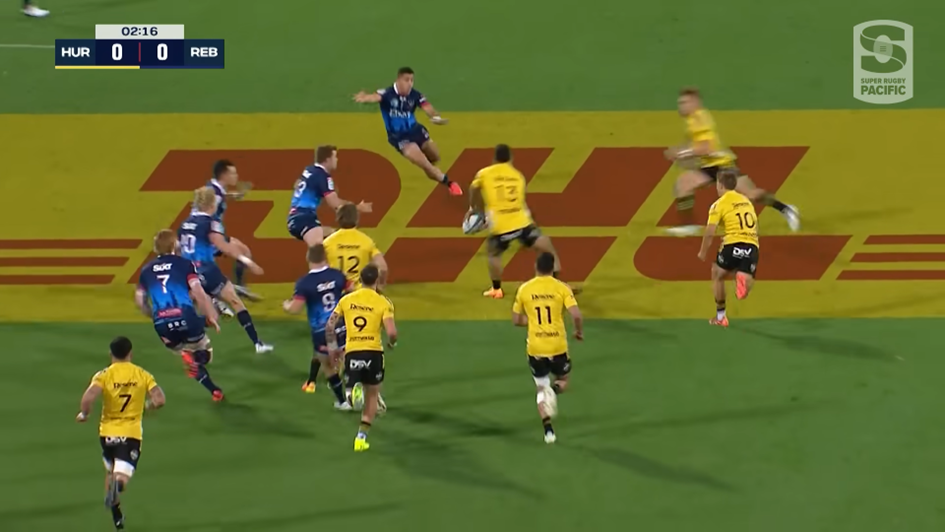
Vaihu has bitten in on Love, leaving Morgan free to create the overlapSeven minutes later, the Canes have another lineout, this time just inside the Rebels 22.
The Canes set up in the same formation and you can see how the Rebels midfield defender, Kellaway, identifies this. This time, he aims to shut down the overlap by targeting the out the back option (Morgan). The only problem is that the Hurricanes have gone for one of their slight variations: Perenara holds the ball a fraction longer, Proctor, the arrow runner, drifts to Kellaway’s inside shoulder and when the 9 passes, a gap has already been created through the Rebels’ midfield’s anticipation of the back-door option. They have taken their eyes off the arrow runner as a potential carrier, leaving the latter to simply run through the space and score the try. Simple but effective.
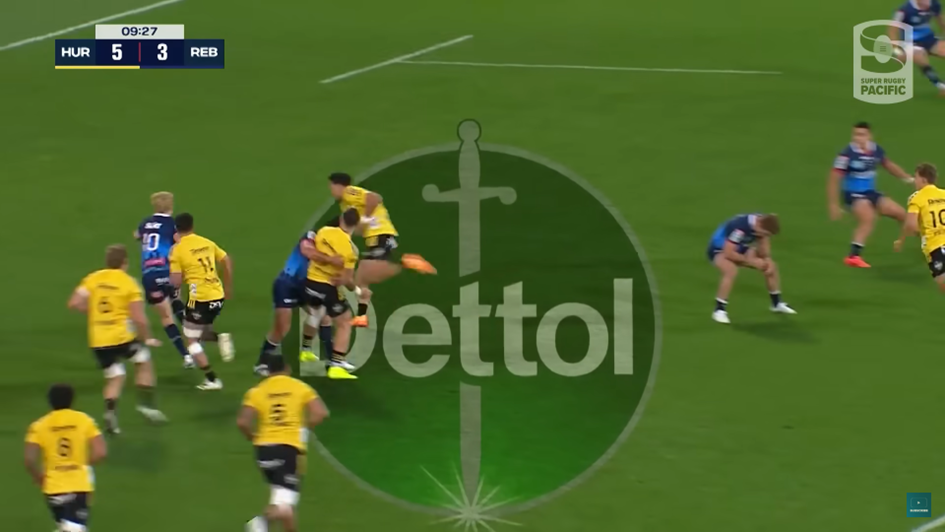
A visibly dejected Kellaway, after being burned again by the strike playThe six+1 lineout strike made regular appearances in the Hurricanes’ highlight reels across the Holland seasons. I’m sure it greatly enhanced Holland’s reputation as a set-piece specialist. It is also understandable how a portfolio like Holland’s would be attractive to someone like Scott Robertson. While Robertson is a firm believer in defence, counter-attack and set-piece pressure, set-piece attack, especially the lineout peel in the opposition 22, was a staple of the Crusaders during Razor’s tenure. It typically acted as a kind of secondary source of scoring income, an added platform for opposition pressure rather than the core game plan. The in-play superiority of the team would set the team up for victory, and the set-piece attack could act as the killer blow. While Hansen is Razor’s trusted companion, Holland seemed to be appointed to be his sword. So why was it so blunt against France?
Lineout attack at the Stade de France
At first, it seemed as if the Hurricane lineout strike would not get to make an appearance in the test match. Instead of the typical six-man lineout set-up, with the +1 in the boot to act as the in-field passer, the ABs went for five-man lineouts, with Roigard at the base to throw the in-field pass to Barrett at first receiver. Rather than set-up for any sort of immediate strike, the goal seemingly was to secure possession and settle into phase-play, with several passages of play after an NZ lineout going to 7+ phases. While these lineout attacks weren’t necessarily unsuccessful – apart from the botched Savea to Ioane transfer in midfield and the breakdown penalty – it ultimately resulted in very little on the scoreboard, New Zealand’s tries coming from good counter-attack on kick return and a forced turnover around the French 22.It was only in the 52nd minute, after France had just scored two quick tries in succession, that the call came for a six-man lineout, with Lakai in the boot. It was a field position typical for the Hurricane lineout strike, in and around the opposition 22, with the likely goal being to create a scenario where Caleb Clarke is put into space and in a one-on-one situation close to the try line.
The French, however, quickly identified what was coming: Roumat immediately spots the pattern, runs to the middle while calling lifters to him and promptly steals the ball.
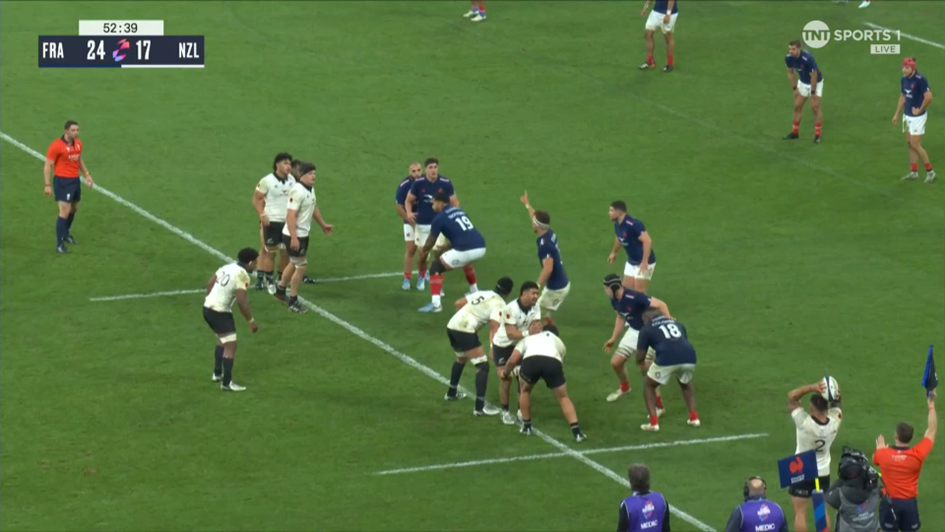
Roumat calling lifters to him after seeing what’s about to happenThe ABs would get another shot at it in the 59th minute, after a breakdown penalty won by Savea. With the gap at seven points, this is the perfect moment to pull out a strike with a high-success rate. The lineout set-up is the same, 6+1, only this time the call is to go to the front. Savea secures the ball and transfers quickly to Lakai, who throws the pass to Ratima. The 9 passes long to ALB who acts in this scenario as the arrow runner. In an interesting variation to the play – which catches the French midfield defence off guard – Lienert-Brown quickly passes to Ioane, who, instead of acting as the dummy inside cut, functions as a sort of secondary arrow, with McKenzie on his shoulder and Barrett as a back-door option.
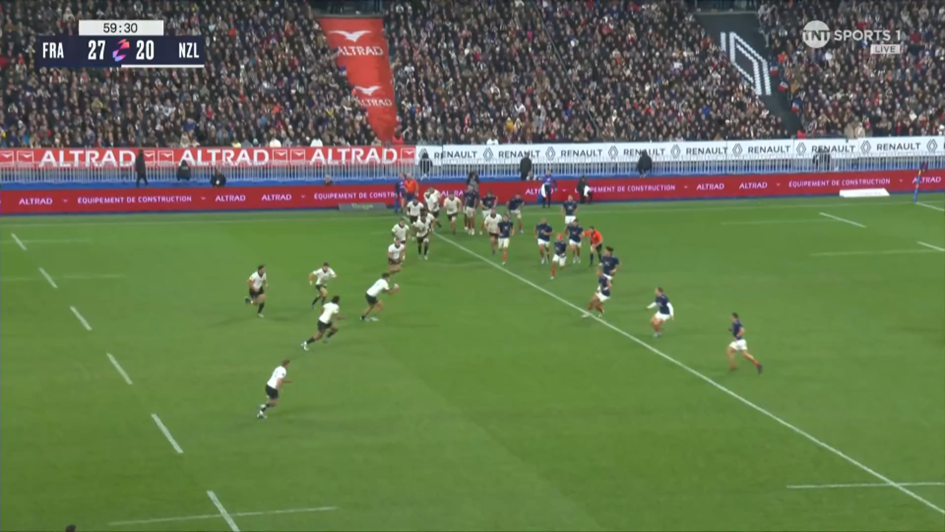
In the standard play, ALB would take up the ball, with Ioane as the dummy runner. Instead, ALB passes to Ioane, creating a secondary arrow.The variation works, as Ramos is caught in no man’s land, allowing Ioane to put McKenzie into space who still has Jordan on the outside.
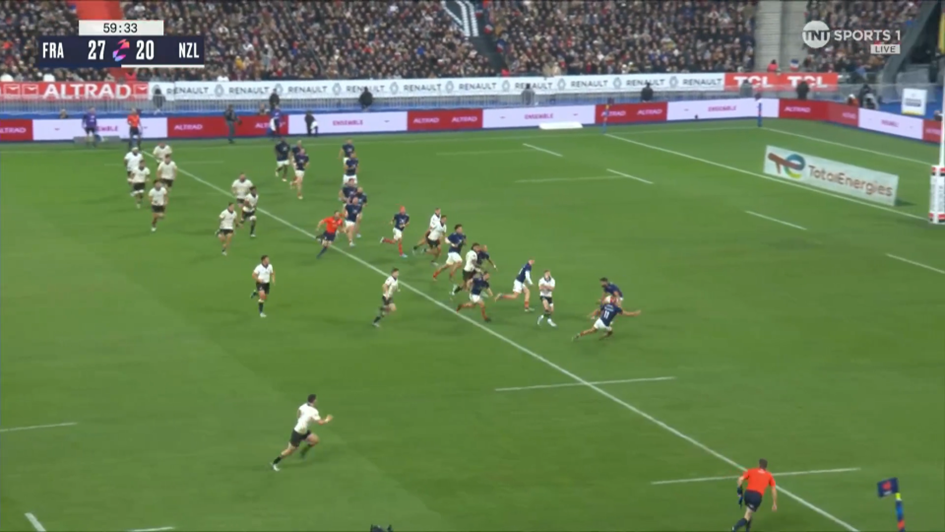
Bielle-Biarrey seems fixed but isn’t.The only thing that saves France is Bielle-Biarrey’s ability to act as two defenders at the same time. First, he is in position to make a tackle-assist on McKenzie but as soon as the latter passes to Jordan, he uses his incredible pace to shut down the space in the corner. Jordan is unable to finish against the French scramble defence and the AB trump card, the Hurricane lineout strike, is successfully foiled.
This is, at least, one good reason why Barrett didn’t go for the corner at the end of the game, as one of the signature strike moves of Holland had been earmarked and recognized by the French defence, both at the lineout (Roumat) and in the scramble (Bielle-Biarrey). If your opposition already knows what is coming, your chances of success drop drastically. Even when the ABs used an unexpected variation to the strike with the secondary arrow, the French defence was still able to adjust quickly.
AB lineout attack in 2024: a mixed bag
Another potential reason for Barrett’s choice is that the NZ set-piece attack has had a season with very mixed results. There were some great tries scored off lineout (SA 1, ENG) and scrum (JP), but other promising movements often fell short through lack of execution. There were also quite a few signs that what worked well in Super Rugby didn’t translate so well to test rugby, including the signature Hurricanes lineout strike.The second game against the Springboks in Cape Town offers some nice examples of this difficult transition, in my view. After creating a lot of opportunities but just coming up short in Joburg, the ABs, once again, were able to produce plenty of line-breaks off lineout attack in Cape Town. In the 13th minute, for example, the ABs have a lineout near the Springbok 22:
Cane breaks off of his position as plus one and Taylor throws it over the top. After a relatively quick recycle, Sititi makes a powerful midfield carry. The Springbok defence is struggling to keep the pace with the AB attack and in the next phase, Ratima passes to Savea who, targeted by both De Allende and Du Toit, passes back inside to Taylor who makes the line-break, as Wiese is too late in taking up his spot on Pieter-Steph’s inside. While this is a nice lineout strike, at the same time, this is the situation immediately after the line-break:
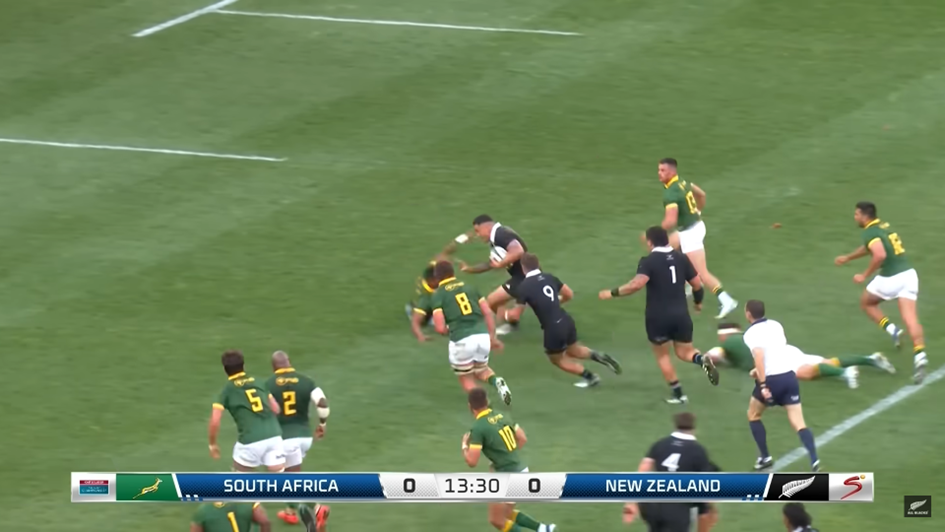
The Springbok defence is more alert to the break than the ABs. Scott Barrett is watching it all unfold and Sititi is only just getting off the floor. While Tamaiti Williams has nicely anticipated the situation, Ratima is the only realistic option to finish the break. Seeing this, Wiese follows the script from the RWC final (run every single support runner off their line, at whatever cost) and clumsily trips up the AB 9, costing himself a trip to the sinbin.
This simple fact – that Test defences react much, much quicker to breaks than Super Rugby defences – has been the single biggest Achilles heel of the 2024 AB lineout attack, as it has been unable to fully anticipate this fact into its strikes. One final example to show this, and where else to finish than with the Hurricane lineout strike.
In the 56th minute, with the ABs trailing the Springboks 13 points to 9, New Zealand has a lineout within the Springbok 22.
The six-man plus one formation is called and, after Barrett secures the ball at the front, Cane acts as the in-field passer to Perenara at 9. Perenara throws a long pass to the arrow runner, ALB, with Jordan running the dummy cut. Lienert-Brown passes out the back to McKenzie, who has Ioane on his shoulder and Reece out wide. McKenzie passes short to Ioane to bypass Kolbe, allowing Rieko to release Reece towards the corner.
Besides the addition of Ioane – which is necessary because of the throw to the front as well as the presence of the Springbok defensive shooter (Kolbe) – this is a mirror image of the typical Hurricane lineout strike. As a result, we can compare some stills side-by-side (I have taken a Hurricanes lineout strike from their game against the Fijian Drua in 2023:
First, the situation of the arrow runner when he is close to the line.
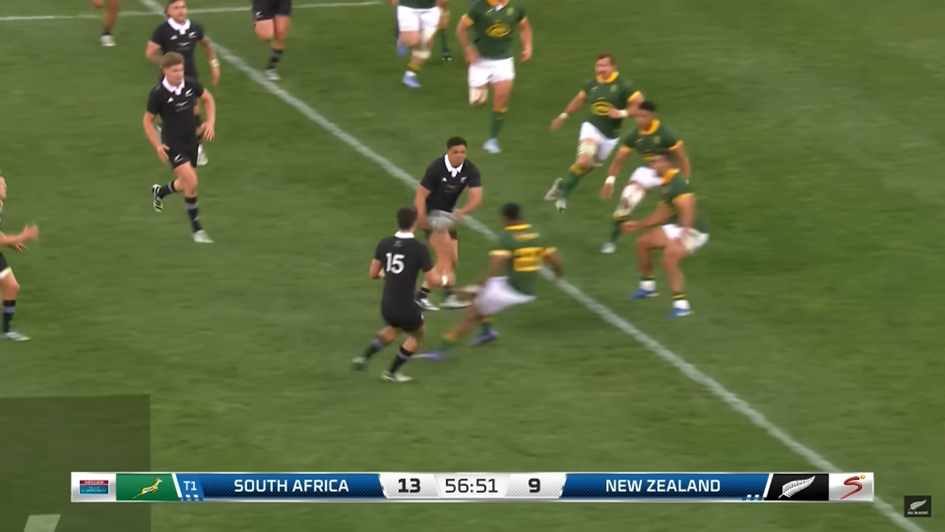
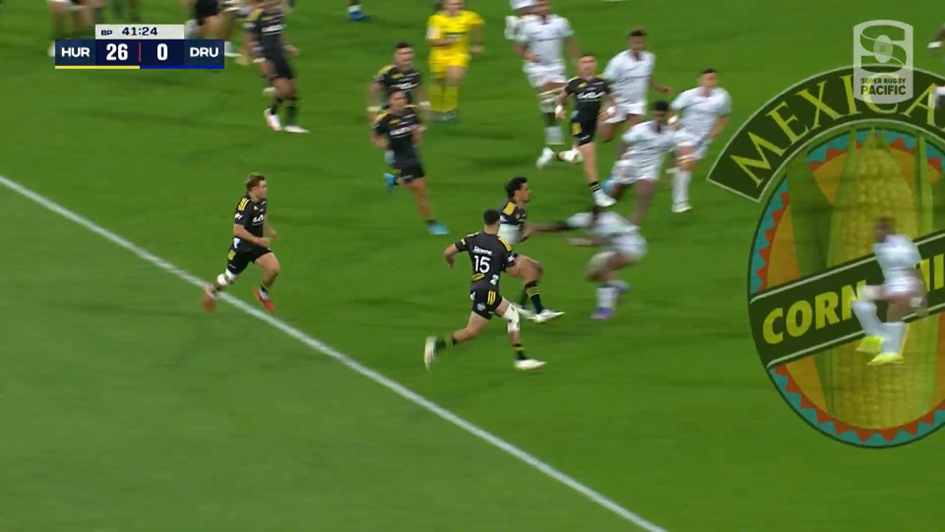
What is noticeable is how different the space off of the arrow runner’s shoulder is in both situations: whereas in the Canes example Moorby is still a solid option for the pop-pass by Sullivan, forcing the Drua edge defender to turn inside, against the Springboks, Am has beaten Jordan into this space. The Jordan dummy run then has no effect on the Springbok scramble to the outside, as they can fully focus on the backdoor options and collectively push to the outside.
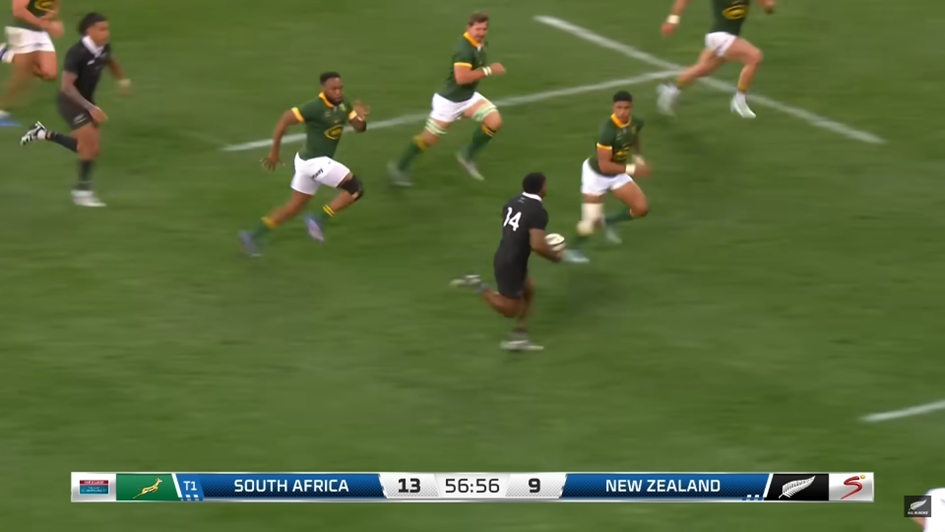
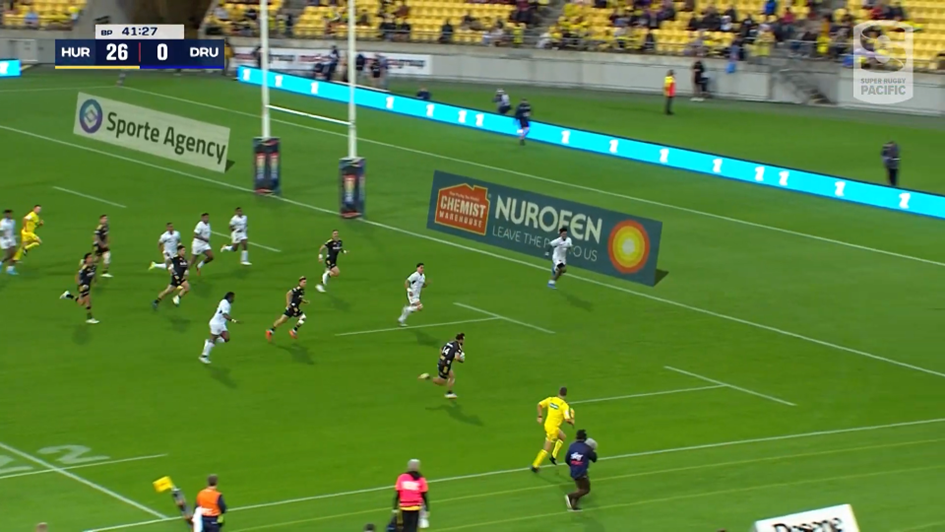
This is the end result of both strikes. Whereas the Fijian Drua defence is comprehensively outflanked by the play, leaving Goosen a simple run-in try, the Springbok defence, on the other hand, has outpaced the AB attack to the corner, leaving Reece face-to-face with four Springbok defenders on their feet. A few aspects have led to this situation: the throw to the front rather than the middle, which means that there is more space to make up; the necessity of McKenzie being a metre further back in order to be able to execute the overlap with Ioane against the Springbok shooting defender (Kolbe); and Jordan being beaten to the space, leaving the scramble defence free to sprint to the outside. These are matters of inches and seconds, but, as it turns out, that is the difference between scoring and getting turned over, between winning and losing.
Returning to the 74th minute in Paris
We will never know what was really going on in Scott Barrett’s head when he pointed to the sticks near the end of the Test match against France. Perhaps he felt they were on the right side of the referee and could eke out a win through Razor’s principles of in-game superiority: defensive intensity, set-piece superiority and dynamic counter-attack phase-play, forcing a penalty in the dying minutes. What we do know, is that he didn’t feel comfortable going to the Hurricane lineout strike as a means of guaranteed points. After being foiled in Cape Town, the French defence had shown itself more than capable of dealing with it as well, both at the lineout and through the scramble, even in the face of clever innovations. If the Hurricane lineout strike is going to return to Test rugby in 2025, Jason Holland will need to find a way of sharpening it, where it can finally cut through South African and French Test defences. If he can, we can expect some of these results to reverse in the next Test season. If he doesn't, Barrett will have to keep going for 3, hoping that this time they can secure an opportunity for the winning kick.
